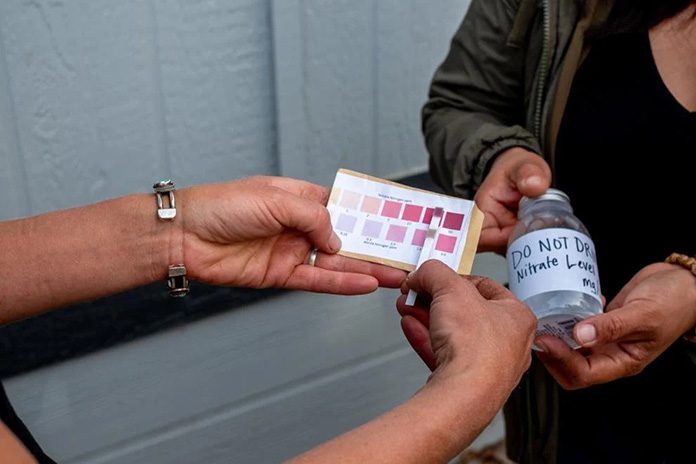
The Morrow County Planning Department is ready to take the first official steps in a plan to address the drinking water crisis in the Lower Umatilla Basin Groundwater Management Area.
Morrow County partnered with Umatilla County to apply for funding from the Environmental Protection Agency to secure funding for a project looking at mid-term and long-term solutions or alternatives for private drinking water wells that have high levels of nitrates.
In October, the EPA awarded the counties a grant of $1.7 million, with Morrow County as the fiscal agent. As of Thursday, Dec. 21, the counties are ready to accept bids for a contract to develop and carry out a work plan.
The Lower Umatilla Basin has had nitrate concentrations above state and federal standards since at least 1990, when the Oregon Department of Environmental Quality designated it a groundwater management area.
There are around 3,300 private wells in use within the LUBGWMA, which covers an area of 562 square miles, stretching east across northern Morrow County and into northwestern Umatilla County.
Morrow County Planning Director Tamra Mabbott reported the status to county commissioners on Dec. 20. Later, she said the award from the EPA will help the counties fit a niche existing efforts haven’t filled.
What exists today
The LUBGWMA has a committee made up of 11 representatives from various groups, including local governments, science and research, livestock and agriculture, environmental organizations and the general public.
This committee works on long-term solutions to reduce the nitrates in the groundwater and collect data for the DEQ. The committee takes a big-picture approach, looking at the whole aquifer.
On the other end, there are immediate efforts to provide clean drinking water to people whose wells have high nitrate levels. Morrow County in June 2022 declared a drinking water emergency, which brought a new level of attention to the issue from state and federal entities.
Since the declaration, a lot of sampling has been done at wells across the management area, and the Oregon Health Authority, along with community groups and public health departments, has provided clean drinking water to anyone who needs it. This mitigates the problems caused by the nitrates. There are public and private efforts to improve water quality and reduce nitrates getting into the water, Mabbott said.
“There are a lot of farmers who spend time and effort to study precisely how much water and fertilizer they use so it doesn’t go into the aquifer,” she said. “Food processors are doing a lot as well. It’s best business practice to properly manage all that.”
But these approaches address the immediate need — clean drinking water — and the path toward a permanent solution — cleaning up the aquifer and reducing the overall nitrate levels — and they do not address what is going to happen to the existing domestic wells.
The path ahead
That’s where this EPA funding comes in, Mabbott said. The project is called the Morrow and Umatilla County Drinking Water Investigation. The funding comes from a research and science grant, so the request for proposals has a heavy emphasis on research.
“The purpose of this grant is to study, more focused, on the wells that have high nitrates and to identify alternatives where it might be feasible to connect to a city system or to build a municipal system,” Mabbott said. “Or even to drill a deeper well. We’re confident that there are multiple solutions.”
This is an important piece of solving the nitrate problem because private well owners aren’t required to test or treat their water, and they can drill a well without water rights. They also don’t face oversight about maintaining their septic systems.
Comparatively, public systems require testing and treating the water and are required to be careful of how that interacts with the septic system, pumping every five to seven years.
The counties are going to hire contracted engineers to check out individual wells and find out the details about each one — exact geolocation, when it was drilled, how deep it is, whether it was cased — to come up with a plan to determine where it might be possible to include individuals in a public water system or where other solutions may be necessary.
There are three phases to what the engineers will do, Mabbott said.
First is a testing phase, then outreach to the community and evaluating collected data, then making recommendations and an action plan for the counties. Mabbott expects to hire the contractors for $1.3 million or so of the initial $1.7 million that was granted.
Ready to research
Mabbott also said she worries people might wonder why data that’s already been collected can’t be used instead of collecting new information.
Although that data was enough to help ensure people could access clean drinking water, she said, the protocol for sampling the wells to meet an immediate need is different from studying it to determine details of the well to figure out if the owner can be connected to public water systems.
This data will allow the counties to take the next steps in getting people access to clean drinking water without the intervention of public health officials, but the project likely will take several years.
The proposals from engineering firms are due Feb. 2. At that point, a scoring committee will meet to decide which contractor to hire, then meet with them to see how they’d like to move forward. There will be a joint session between Morrow and Umatilla counties in March, and then the investigation will begin.
Morrow County has applied for additional funding that would apply to whatever results they find from the upcoming investigation. That funding would help them design and engineer the solutions from the action plan that will be developed from the initial research.
“There’s a lot of criticism about what the state’s not doing,” Mabbott said, “but this is a huge effort for the counties to take on this investigation.”









